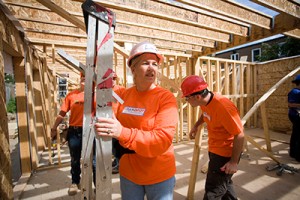Former CEO of Home Depot Canada takes reins of energy storage initiative
 Annette Verschuren, the former chief executive of Home Depot Canada who once worked for the agency in charge of Nova Scotia’s coal mines, has dedicated the next phase of her career to being an enabler of renewable energy.
Annette Verschuren, the former chief executive of Home Depot Canada who once worked for the agency in charge of Nova Scotia’s coal mines, has dedicated the next phase of her career to being an enabler of renewable energy.Verschuren announced last week that she is taking on the role of executive chair at energy storage start-up NRStor Inc., which was created to help commercialize new energy storage technologies and has an ambitious plan to set up the first energy storage park in Canada, most likely in Ontario.
“This sector has always been an interest to me,” Verschuren said in an interview. After leaving Home Depot Canada, she spent a lot of time travelling — visited 15 countries, in fact — and got to see both the potential and challenges of deploying renewable energy in jurisdictions that could benefit from it most. “Energy storage is the missing link.”
NRStor itself is the creation of Toronto-based Northwater Capital Management Inc., an early stage investor in a number of clean technologies, including energy storage. One of its major investments to date includes Newton, Mass.-based General Compression Inc., a pioneer in the development of compressed-air energy storage systems.
Such systems use off-peak, surplus or intermittent electricity supply to compress and inject air into underground storage areas, such as depleted oil and gas reservoirs or salt caverns. At peak times when the electricity is needed most, the air is released and drives a power-generating turbine as it decompresses and expands.
General Compression has figured out a way to do this without assistance from fossil fuels and in a way that emits virtually no carbon emissions. In a partnership with ConocoPhillips, the company is developing a 2-megawatt demonstration project in Texas that can back up wind farms by absorbing their excess energy and dispatching it when needed.
It’s not perfect. For every 100 units of energy that goes into what is essentially a compressed-air “battery” only 70 to 75 units come back out. But such “round-trip efficiency,” as it’s called, is consistent with chemical batteries and other storage technologies.
Another Northwater investment is Mississauga-based Temporal Power Inc., developer of a highly efficient flywheel energy storage system that I first wrote about in April 2011.
Flywheels are basically large cylindrical masses in a protective housing that are designed to spin in a near frictionless environment. Electricity used to spin the mass is stored as kinetic energy — that is, the spinning itself — and when that rotating mass is connected to a generator the energy is converted back into electricity.
Jeff Veltri, founder and chief technology officer of Temporal, says the less friction there is the more efficient the device. His flywheel system has such low friction, he claims, that it can hold up to 95 per cent of its charge for several hours — a breakthrough if demonstrated in real-world conditions. The company is collaborating with Hydro One on a pilot project to prove just that.
Verschuren said the energy storage park NRStor plans to build will incorporate both General Compression’s and Temporal Power’s technologies. The company is also looking at a variety of battery technologies. She insisted this isn’t going to be just another demonstration project.
“This storage park would be a commercial operation,” she said. “I’m very interested in making money, making things happen, at the same time recognizing what problems are in the world and how we can solve them.”
Sites across Canada are under consideration, but she hinted the timing may be right in Ontario. There are plenty of salt caverns and depleted gas fields in southwestern Ontario that could prove ideal for compressed-air energy storage. The area has plenty of wind farms that could be greatly enhanced with backup storage, and the transmission infrastructure is there.
Ontario could also benefit tremendously — particularly these days. Lower energy demand as a result of a slowing economy, uncharacteristically warm winter weather, summer conservation efforts, rain-charged hydro resources, inflexible nuclear power stations, and intermittent wind resources all add up to more occurrences of power surpluses.
Instead of paying other jurisdictions to take the excess power we generate, why not store it and use it for ourselves when we need it most?
Unfortunately, getting a multi-megawatt storage park built in Ontario won’t happen overnight. Regulations, for one, need changing. We need clearer rules that determine how storage operators can buy and sell what is essentially an electricity service.
“My job is to set this up,” said Verschuren. “We’ll put a plan together, logically, and we’ll be working closely with the regulatory environment to get those rules in place.”
It won’t be easy. Home Depot might sell storage solutions to new homeowners, but adding shelving and closet space is nothing like the buying, storing and selling of megawatt-hours on a grid.
And just how many megawatts does Verschuren see her storage park reaching? “We want to go to 2,000 megawatts,” which is close to the size of two nuclear power reactors in Ontario, she said. “But it will be a stepped up process.”
Ambitious — and welcome. Glad somebody is giving it a shot, and helping pave the way for others to follow.
You can return to the main Market News page, or press the Back button on your browser.

